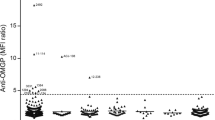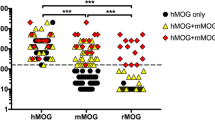Abstract
Myelin oligodendrocyte glycoprotein (MOG) is a member of the immunoglobulin superfamily expressed exclusively in central nervous system (CNS) myelin. While the function of MOG is unknown, a number of studies have shown that immune responses to MOG contribute to the autoimmune-mediated demyelination seen in animals immunized with whole CNS tissue. This paper summarizes our recent studies, which unequivocally demonstrate that MOG by itself is able to generate both an encephalitogenic T cell response and an autoantibody response in Lewis rats and in several strains of mice. In Lewis rats the injection of both native MOG and MOG35–55 peptide produces a paralytic relapsing-remitting neurological disease with extensive plaque-like demyelination. The antibody response to MOG35–55 was highly restricted, as no reactivity to either other MOG peptides or myelin proteins could be detected. Fine epitope mapping showed that antibody from serum and cerebrospinal fluid of injected rats reacted strongly to MOG37–46, which is contiguous to the dominant T cell epitope contained within MOG44–55. NOD/Lt and C57BL/6 mice were also susceptible to severe neurological disease following injection with recombinant MOG or MOG35–55 peptide, indicating that this specific CNS autoantigen, or some of its determinants, can induce a pathogenic response across animal species. Severe paralysis and extensive demyelination were seen in both strains, but NOD/Lt mice experienced a chronic relapsing disease whereas C57BL/6 mice had a chronic non-remitting disease. Moreover, transfer of MOG35–55 T cells into naive NOD/Lt mice also produced severe neurological impairment as well as histological lesions. These results emphasize that a synergism between a T cell-response and anti-MOG antibodies may be important for the development of severe demyelinating disease. This, together with our demonstration that there is a predominant T cell response to MOG in patients with multiple sclerosis, clearly indicates that MOG is probably an important target autoantigen in this disease.
Similar content being viewed by others
Author information
Authors and Affiliations
Additional information
Received: 6 June 1996 / Accepted: 20 August 1996
Rights and permissions
About this article
Cite this article
Bernard, C., Johns, T., Slavin, A. et al. Myelin oligodendrocyte glycoprotein: a novel candidate autoantigen in multiple sclerosis. J Mol Med 75, 77–88 (1997). https://doi.org/10.1007/s001090050092
Issue Date:
DOI: https://doi.org/10.1007/s001090050092




